中国气象学会主办。
文章信息
- 郑然, 刘嘉慧敏, 马振峰. 2018.
- ZHENG Ran, LIU Jiahuimin, MA Zhenfeng. 2018.
- 夏季西太平洋暖池热含量对华西秋雨的影响及可能的物理机制
- Impacts of the summertime warm pool in the West Pacific on Huaxi autumn rain and its possible physical mechanism
- 气象学报, 76(5): 714-725.
- Acta Meteorologica Sinica, 76(5): 714-725.
- http://dx.doi.org/10.11676/qxxb2017.080
-
文章历史
- 2017-12-17 收稿
- 2018-05-31 改回
2. 中国气象局成都高原气象研究所/高原与盆地暴雨旱涝灾害四川省重点实验室, 成都, 610072;
3. 陕西省气象台, 西安, 721001
2. Institute of Plateau Meteorology, China Meteorological Administration/Heavy Rain and Drought-Flood Disasters in Plateau and Basin Key Laboratory of Sichuan Province, Chengdu 610072, China;
3. Meteorological Observatory in Shaanxi Province, Xi'an 721001, China
关于中国降水特征及形成机理的研究, 以往多集中于夏、冬两季(Weng, et al, 1999; 王林等, 2011; 李永华等, 2010), 而对于秋季旱、涝特征及成因的研究则相对较少, 但秋季是大气环流转型的过渡季节, 使得一些地区的降水除了夏季的主高峰外还存在秋季的次高峰, 且近年来中国秋季降水呈明显增多趋势(黄琰等, 2011), 这些地区就是典型的秋雨区, 位于中国华西和江浙某些地区(何敏, 1984), 其中尤以华西地区更为明显(顾薇等, 2012), 主要分布于渭水流域、汉水流域、四川盆地、滇东至黔等大部分地区, 称为华西秋雨。强华西秋雨的主要特征表现为较长时间的阴雨寡照, 同时导致气温下降, 对粮食的成熟及收割、人民生活等均会带来一定不利影响。强华西秋雨所造成的灾害已是中国主要气象灾害之一, 因此, 对华西秋雨强度开展研究和预测具有十分重要的现实意义。
早在20世纪30—40年代, 气象学者已开展针对秋雨的研究(涂长望等, 1935; 张宝堃, 1941; 吕炯, 1942), 认为秋雨是由局地地形及冷空气作用的结果。高由禧等(1958)发现秋雨的起、止日期与亚洲南部上空急流进退和印度季风进退有关, 袁旭等(2013)认为其可能与东亚夏季风、南亚夏季风向冬季风的转变时间不同步有关, 二者共同作用使得华西秋雨成为亚洲夏季风在中国大陆上的最后一个雨季, 主要出现在9—10月。华西秋雨在空间分布上主要表现为南北相反和全区一致的特征(白虎志等, 2004), 且在时间变化上具有阶段性和周期性(冯丽文, 1983), 21世纪以来进入秋雨明显期(方建刚等, 2005; 贾小龙等, 2008; 薛春芳等, 2012)。对于秋雨的成因, 从大尺度环流背景来看, 巴尔喀什湖低压槽、西北太平洋副热带高压、印缅槽等是影响华西秋雨的主要环流系统(鲍媛媛等, 2003; Niu, et al, 2008; 罗霄等, 2013; 王春学等, 2015), 此外, 大气热源、青藏高原地面热源等因子均在前期或同期过程中对华西秋雨的强度产生一定影响(李跃清, 1994; 陈忠明等, 2001; 陈少勇等, 2011)。可见, 华西秋雨已得到众多学者的重视, 并对其形成原因已有一定的认识, 但寻找有效前期预测因子作为预报信号的研究相对较少。
研究表明, 海洋是影响大气环流的重要因子之一(Zhou, et al, 2009; Li, et al, 2011), 由于其具有巨大的热容量, 使得其成为具备长时间记忆能力的缓变因子, 是影响季节降水异常的重要前期信号(李崇银, 1992; 肖子牛等, 2002; Zhu, 2011)。海表温度是海洋信号最直接的代表, 且其异常必定引起大气环流异常, 而厄尔尼诺-南方涛动(ENSO)作为影响降水的重要因子, 其对秋季降水的影响可能比对夏季降水的影响更加显著(龚道溢等, 1998; 谌芸等, 2003), 李耀辉等(2000)的研究表明, 赤道中东太平洋海表温度异常与西北秋季大范围的区域性降水异常有较好的对应关系。顾薇等(2012)、韩晋平等(2013)的研究也表明, 热带太平洋海温异常与中国秋季降水变化密切相关。近年来, 有学者指出, 海洋热含量较海温更稳定, 可作为中国降水异常的有效前期信号(林传兰, 1990), 此后, 不少学者针对海洋热含量对中国降水异常的影响展开了研究, 并得到十分有意义的结论(王晓芳等, 2013; 尚可等, 2014), 此外, 刘嘉慧敏等(2015)发现, 前期4月西北太平洋潜热通量与中国南方秋季降水成显著正相关。可见海洋是影响秋季降水异常的重要前期信号, 而海洋热含量已成为一个重要的预报因子, 那么其对华西秋雨强度是否有一定影响, 是否可作为华西秋雨强度预测的一个前期信号, 很值得探究。
2 资料和方法所用资料包括:1971—2012年中国753站逐日降水、日照时数资料; 日本气象厅提供的逐月历史海温资料(Ishii, et al, 2006), 水平分辨率为1°×1°, 深度有24层; NCEP/NCAR逐月位势高度场、风场等(Kalnay, et al, 1996), 水平分辨率为2.5°×2.5°。
对华西秋雨的定义, 参考蒋竹将等(2014)提出的综合考虑雨日、雨量和日照时数定义的华西秋雨指数(单位:d)

|
(1) |
式中, Raut为各站9—10月秋雨期内降水量, Ryear为各站年降水量, L为秋雨日数:若某一天气象台站出现有效降水(日降水量≥0.1 mm)且日照时数小于0.1 h, 则为一个秋雨日, 否则为非秋雨日。
为确定华西秋雨区, 依照上述标准选取秋雨站点。首先选取1971—2012年中国资料较为完整的595个气象台站, 计算各站逐年秋雨指数(IMAR), 并将各站42年秋雨指数进行降序排列, 提取前10%的站点作为华西秋雨典型区, 计算中发现海南的琼海站也属于前10%站点, 但由于其不属于华西地区, 因此将其剔除, 最后所得到的站点即为华西秋雨区站点(图 1)。
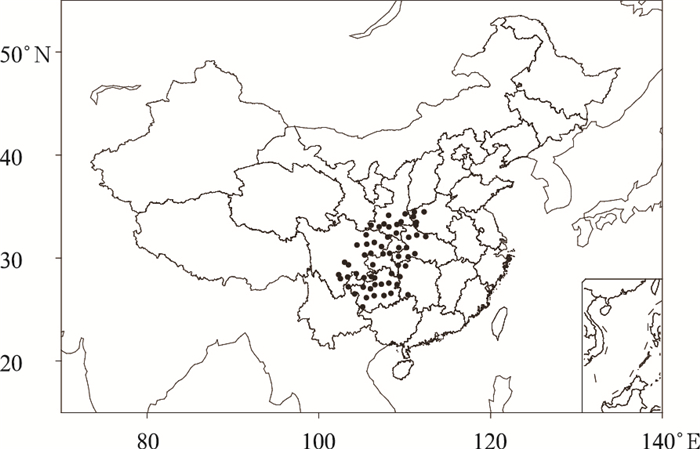
|
| 图 1 华西秋雨区站点分布 Figure 1 Distribution of stations in Huaxi autumn rain area |
热含量的计算采用白虹等(1989)的计算方案

|
(2) |
式中, 
将华西地区各站秋雨强度指数进行区域平均, 可得到华西地区秋雨强度指数(图 2), 可以看出, 华西秋雨强度存在明显的年代际变化, 从20世纪70年代至21世纪以来, 秋雨强度存在“减弱-加强-减弱-加强”的循环变化, 年际波动较大, 且不存在明显的趋势特征。

|
| 图 2 华西秋雨强度指数年际变化 (点划线为秋雨强度指数, 虚线为4次多项式回归) Figure 2 Interannual variability of Huaxi autumn rainfall intensity index (the dot-dash line shows the autumn rainfall intensity index, the dotted line is the 4th degree polynomial regression result) |
为探讨不同地理区域的特征变化, 对华西秋雨指数进行旋转正交经验函数(REOF)分解, 由图 3a可以看到, 华西秋雨指数REOF第1模态反映了华西秋雨全区一致变化, 但是, 华西秋雨强度存在南北差异, 这与近年来中国国家气候中心对华西秋雨监测中存在南北分区特征是一致的, 可见经验函数分解得出的第1模态能够反映出华西秋雨的时、空分布特征, 因此, 取其对应的时间序列Rpc1(图 3b)作为研究对象, 反映华西秋雨的年际变化, 后文中即用Rpc1来代表华西秋雨的年际变率。
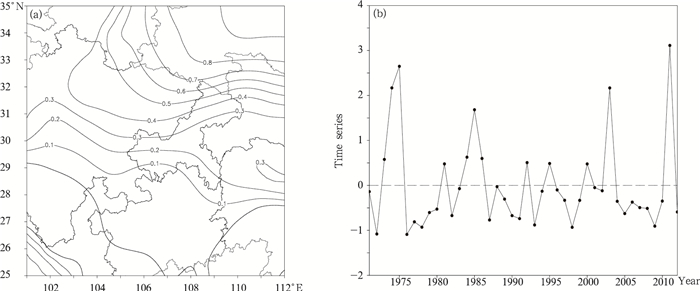
|
| 图 3 1971—2012年华西秋雨指数旋转正交经验函数分解第1模态(a)及其时间系数序列(b) Figure 3 The first REOF mode of the autumn rainfall for 1971-2012 in Huaxi (a) and its associated time series (b) |
那么华西秋雨强、弱年下, 大气环流及水汽的整体状况是如何的?根据Rpc1选取华西秋雨偏强年(1974、1975、1985、2003、2011年)和偏弱年(1972、1976、1978、1998、2009年)各5年, 进行500 hPa高度场和整层水汽通量及其散度的合成差值分析。从图 4a可以看出, 华西秋雨偏强年, 纬向上从乌拉尔山至中国东部, 形成了一个西北—东南走向的“+-+”波列型分布, 在东亚中高纬度呈典型的东高西低型, 经向上在热带至东亚中高纬度沿岸地区呈“- + -”波列型分布, 类似于太平洋-日本波列正位相(Nitta, 1987)。从水汽场(图 4b)可以看出, 整层水汽通量在中南半岛附近呈气旋式环流, 其北侧偏东偏南气流将中低纬度海洋的暖湿水汽向西输送, 由于受高原地形阻挡, 南海附近的东南水汽输送及约30°N的偏东风水汽输送只能到达100°E左右, 故使得整层水汽通量正好在华西地区上空显著辐合, 这就为强秋雨提供了充足的水汽条件。

|
| 图 4 500 hPa位势高度异常(a, 单位:gpm, 实线为正值, 虚线为负值, 阴影区为通过了95%的显著性t检验)和整层水汽通量(矢线, 单位:kg/(m2·s))及其散度(b, 水汽通量散度仅用阴影标明通过95%的显著性t检验的辐合区)在华西秋雨强弱年9—10月的合成差值场 Figure 4 Composite differences of 500 hPa geopotential height anomaly (a, unit:gmp, shadings indicate the monthly correlation is significant at the 95% confidence level) and whole layer moisture transport and moisture divergence (b, vectors denote the vertically integrated moisture transport; the divergence only show the convergence zone that value being significant at the 95% confidence level with shadow, unit:kg/(m2 s)) during September-October |
为探讨前期暖池热含量是否与华西秋雨强度存在某种联系, 先分别求Rpc1与前期1—8月的热含量距平场相关(图 5), 结果发现从前期6月开始, 暖池区热含量出现与华西秋雨指数的显著正相关区, 且随着时间推移持续加强, 范围加大, 说明该区热含量可能与秋雨强度存在显著正相关关系, 且具有较好的持续性, 为探寻其是否可作为有效前期因子来影响华西秋雨强度, 根据显著相关区, 取夏季(6、7、8月)作为关键时段, 将暖池区(5°S—5°N, 130°—160°E)热含量距平场作为与华西秋雨强度指数变化紧密联系的前期暖池热含量关键区。进一步计算关键区内热含量距平场与Rpc1的相关(图 6), 可以看出, 前期暖池关键区热含量与Rpc1均处于正相关, 且随时间推移相关系数逐渐增大, 但1—5月相关较弱, 从6月开始通过90%的显著性t检验, 至8月已通过99%的显著性检验, 夏季平均则通过了98%的显著性t检验, 说明当前期关键区内热含量异常偏高时, 华西秋雨偏强, 反之亦然, 这一结果与图 5一致, 说明暖池关键区热含量变化与华西秋雨强度演变可能存在一定关系, 这也表明所选的暖池关键区内的热含量异常变化较好地反映出热含量与华西秋雨相关关系的季节演变。因而将42年夏季暖池关键区内热含量异常进行标准化处理得到前期夏季关键区热含量指数序列(图 7), 发现其与Rpc1基本呈同位相变化, 相关系数为0.35, 通过了95%的显著性t检验。并以1个标准差为标准确定了7个热含量偏高年(1971、1975、1989、1996、2000、2008、2011年)和6个热含量偏低年(1983、1987、1992、1993、1997、1998年), 这一分类将用在后文的合成分析中。
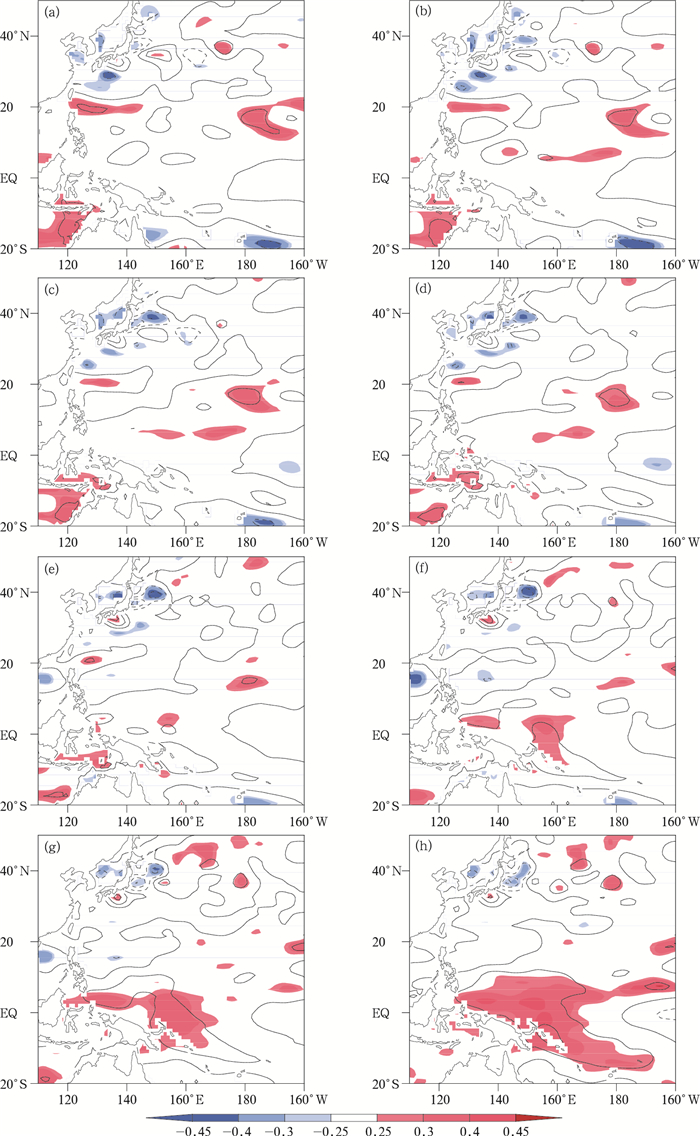
|
| 图 5 Rpc1对当年1—8月(a—h)热含量距平场(单位:J/m2)的回归 (阴影区表示二者通过了95%的显著性t检验, 红色是正相关, 蓝色是负相关) Figure 5 Heat content anomaly (unit:J/m2) regressed upon Rpc1 (shadings indicate the monthly correlation is significant at the 95% confidence level.Red is for positive, blue is for negative) |
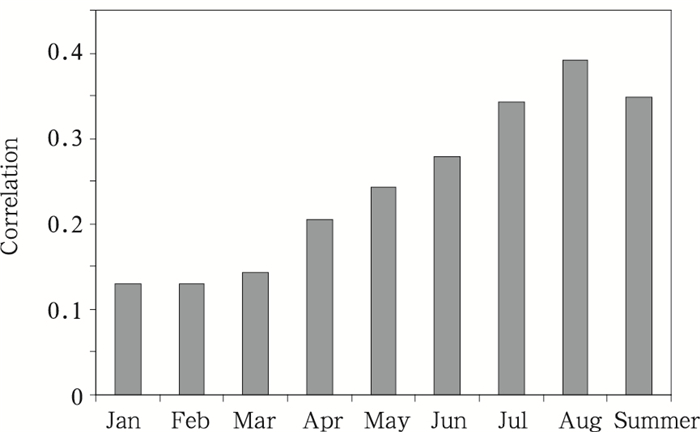
|
| 图 6 暖池关键区热含量距平与华西秋雨Rpc1相关系数 Figure 6 Correlation of heat content anomaly in the warm pool key area and Rpc1 of Huaxi autumn rainfall |
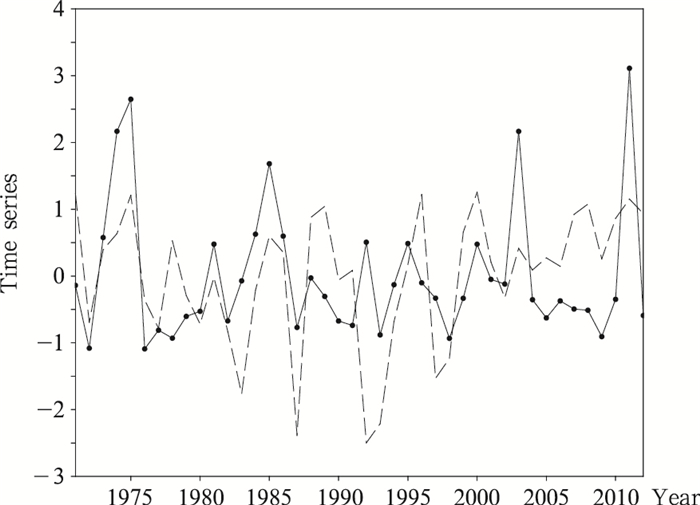
|
| 图 7 暖池关键区夏季热含量标准化序列(实线)与华西秋雨指数旋转正交经验函数分解第1模态时间系数(虚线) Figure 7 Time series of normalized heat content in the warm pool key area in summer (solid line) and Huaxi autumn rainfall Rpc1 (dashed line) |
大气环流异常变化是引起季节降水异常的直接原因, 而上述研究已发现, 前期夏季关键区热含量与华西秋雨强度显著相关, 那么关键区热含量是如何影响大气环流异常变化, 从而对降水产生影响的?下面从高度场、风场、整层水汽通量及散度场等要素异常分布进行分析。
由前期夏季热含量指数与9—10月500 hPa高度场异常回归(图 8a)可以看出, 其与上文分析华西秋雨偏强年与偏弱年的合成差值分布型基本一致, 表现为纬向上形成了一个西北—东南走向的“+-+”波列型分布, 经向上在热带至东亚中高纬度沿岸地区存在明显的北高南低分布, 上述分布型表明当前期夏季热含量指数偏高时, 乌拉尔山阻高加强, 巴尔喀什湖低压槽加深, 中高纬度环流经向度加大, 有利于冷空气南下在华西地区堆积, 同时在印度洋-孟加拉湾地区存在负异常中心, 表明热带扰动较强, 印缅槽加深, 槽前西南气流将低纬度热带地区的暖湿气流向西南内陆输送, 与冷空气交汇, 有助于加大华西地区上层大气的不稳定度。结合700 hPa风场异常回归可以看出(图 8b), 欧亚中高纬度分布与500 hPa基本一致, 值得注意的是华西秋雨区正好处于中南半岛—中国南海气旋北侧的偏东偏南气流控制之中, 有利于将中低纬度洋面的暖湿水汽带到秋雨区, 其同时位于蒙古气旋的偏西偏北气流中, 使得冷空气由高纬度向南输送, 与暖湿水汽交汇, 从而造成秋雨偏强。综合秋雨期500 hPa位势高度异常和700 hPa风场异常分布, 这种纬向上“乌拉尔山强脊-巴尔喀什湖低槽”型环流, 经向上东亚—西北太平洋低纬度至高纬度的南低北高分布, 可使得来自中低纬度洋面的暖湿水汽和中高纬度干冷空气正好在华西秋雨区上空交汇, 有利于降水偏多。反之, 当前期夏季关键区热含量偏低时, 秋季500 hPa位势高度和700 hPa风场的异常分布与偏高年的情形相反, 则不利于华西秋雨偏强。
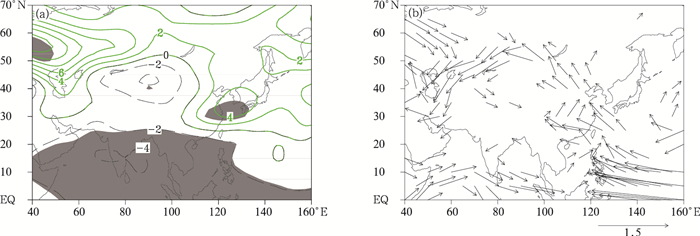
|
| 图 8 夏季关键区热含量指数对9—10月500 hPa位势高度场异常(a, 单位:gpm, 阴影区为通过了95%的显著性t检验)及700 hPa 9—10月风场异常(b, 单位:m/s)的回归 Figure 8 500 hPa geopotential height anomaly (a, unit:gmp, shadings indicate the monthly correlation is significantat the 95% confidence level) and 700 hPa wind anomaly (b, unit:m/s) during September-October regressed upon the summer heat content in the warm pool key area |
图 9a、b分别是前期夏季热含量指数回归的9—10月整层水汽通量及其散度异常场和沿105°E垂直速度经向剖面。可见当前期夏季关键区热含量异常偏高时, 华西秋雨正处于中南半岛—南海气旋北侧的偏东偏南气流控制之中, 它可将中、低纬度洋面的暖湿水汽向西输送, 在华西地区上空辐合。将其与华西秋雨偏强年与偏弱年的合成差值场进行对比(图 4b), 发现二者分布型也基本一致。此外, 在垂直速度异常场上, 华西地区也有明显的上升运动, 从而有利于华西秋雨偏多。
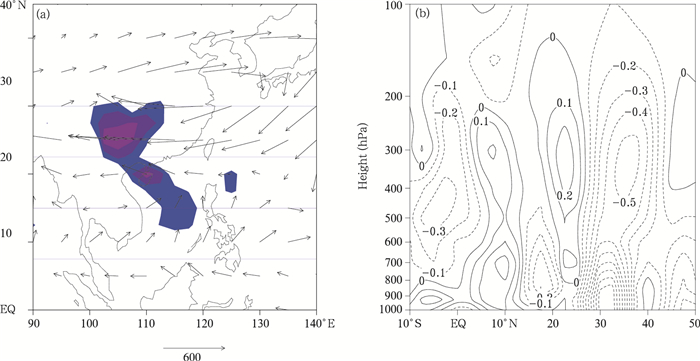
|
| 图 9 夏季关键区热含量指数对9—10月整层水汽通量及其散度的回归(a, 水汽通量为矢量; 阴影区为整层水汽通量散度通过95%显著性t检验的辐合区, 单位:kg/(m2·s))及对垂直速度异常(单位:hPa/s)回归的沿105°E经向剖面(b) Figure 9 Anomalous whole layer moisture transport and moisture divergence (a) (vectors denote the vertically integrated moisture transport; shadings indicate the convergence zone that value being significant at the 95% confidence level, unit:kg/(m2·s)) and the latitude-height cross-section of vertical velocity (unit:hPa/s) along 105°E regressed on the heat content in the key area for the period of September-October |
综上所述, 当前期夏季关键区热含量指数偏高时, 秋季华西地区受到有利于降水的环流系统的影响, 具备有利的水汽条件和垂直上升运动条件, 降水偏多, 反之偏少。这表明前期夏季暖池关键区热含量的变化对华西秋雨强弱有着显著的指示作用。那么, 暖池关键区热源是如何强迫大气, 从而影响华西秋雨呢?特别是低层向华西秋雨区输送大量水汽的中南半岛—中国南海气旋是如何生成?下面进行详细讨论。
4 可能的物理机制在局地海-气相互作用中, 大气除了受自身动力约束外, 也受非绝热加热的直接驱动。夏阳等(2015)研究指出, 影响降水的环流系统异常可能与热带强迫源激发大尺度准定常波的传播有关。海洋系为重要的大气外强迫源, 因而海温的变化与大尺度环流系统紧密相关, 其热源通过对大气环流的强迫, 从而影响局地及更大范围地区的天气气候。
为了进一步理解上述物理信号的物理本质, 对9、10月700 hPa异常风场、高度场进行合成差值分析, 并与热含量指数对其的回归场作比较(图 10), 发现二者分布基本一致。可以看到在700 hPa, 当夏季关键区热含量偏高并持续至秋季时, 由于大气对其的响应, 9月在暖池关键区热源的西北侧生成了异常的气旋式环流, 并持续至10月, 其位于南海—中南半岛附近, 同时伴随负高度异常场(Gill, 1980; 尚可等, 2014), 而华西地区正好位于低层该异常气旋式环流的偏东偏南气流中, 其可将中、低纬度洋面的暖湿水汽向华西地区输送, 这样南下的冷空气与来自中、低纬度洋面的暖湿水汽正好在华西地区上空交汇, 因而有利于华西秋雨偏多。而当夏季关键区热含量偏低时, 若仅考虑影响过程中的线性部分, 那么对应大气环流型则与前者呈相反的情形, 华西地区处于西北气流的控制中, 不利于秋雨偏多。

|
| 图 10 9月(a、c)、10月(b、d)700 hPa位势高度异常场和异常风场在夏季关键区热含量指数偏高年与偏低年的合成差值场(a、b)及关键区热含量指数对其的回归场(c、d) (位势高度异常场为等值线, 单位:gpm, 实线为正值, 虚线为负值, 阴影区为通过了90%的显著性t检验的位势高度异常负值区, 异常风场为流线, 单位:m/s, C为气旋中心) Figure 10 September (a, c) and October (b, d) 700 hPa anomalous geopotential height and wind composite differences between high and low heat content years (a, b) and the differences regressed on the heat content index (c, d) (the anomalous geopotential height is contour, unit:gpm, solid lines are for positive values, dotted lines for negative values, shadings indicate the negative anomalous geopotential height which being significant at the 90% confidence level; Wind is streamline, unit:m/s) |
此外, 将前期关键区热含量指数高、低值年9—10月的200 hPa异常散度场以及风速大于35 m/s的风场进行合成(图 11a、b), 可以进一步看出当前期热含量指数偏高时, 高空西风急流位置较热含量指数偏低年明显西伸, 其入口区右侧的强辐散区也明显向西扩展至华西秋雨区, 秋雨区散度达到3.61 s-1, 而热含量指数偏低年华西秋雨区该层散度仅为0.33 s-1, 强度明显偏弱, 从热含量指数高、低年差值合成场中可以进一步看到二者的差异(图 11c), 即热含量指数高值年时, 华西秋雨区高层为明显辐散场(散度差值为3.27 s-1), 在低层700 hPa上, 华西区则为辐合区(图略), 这样高空强辐散场与低空中南半岛—中国南海异常气旋式环流引起的辐合区正好叠加于秋雨区之上, 有利的耦合形势场促使秋雨区上空上升运动和对流活动的发展, 这在急流的次级环流图中加以印证(图 11d), 可见位于急流入口区右侧的华西地区(25°—35°N)的确存在明显的上升运动, 从而使得秋雨偏多。反之, 前期热含量指数偏低时, 不利的高、低空耦合形势抑制上升运动和对流活动的发展, 使得秋雨偏少。
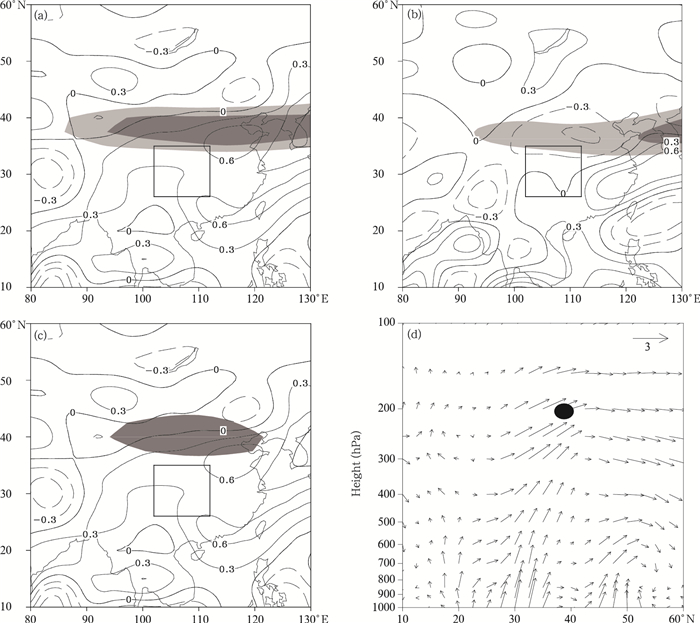
|
| 图 11 200 hPa异常散度在夏季关键区热含量高(a)、低(b)值年9—10月的合成场、高低年差值场(c) (等值线, 单位:10-6 s-1)及高、低年差值沿105°E的经向风场剖面(d) (a、b中阴影区为200 hPa风速的合成, 浅灰色风速大于35 m/s, 深灰色风速大于38 m/s; c中阴影区为200 hPa风场合成差值为正且通过95%的显著性t检验区域, 黑色方框为华西秋雨区; d中单位:m/s, 黑色圆点为高空急流中心) Figure 11 Composite anomalous September and October 200 hPa divergence (contour lines, unit:10-6 s-1) and wind (shaded) (light grey shows wind speed greater than 35 m/s, dark grey indicates wind speed greater than 38 m/s) in high (a) and low (b) heat content years and composite differences (c) between high and low heat content years (shadings indicate the differences are negative and significant at the 95% confidence level), and composite differences in September and October anomalous winds along the longitude of 105°E between high and low heat content years are shown in (d) (unit:m/s, the black dot indicates the jet stream score) |
综上可见, 夏季关键区热含量良好的稳定性使得热含量异常信号持续至秋季, 造成后期环流系统的持续响应。即当前期关键区热含量偏高时, 其相对大气是一个异常热源, 在热源西北侧中南半岛—中国南海附近低空生成了异常气旋式环流, 其偏东偏南气流向华西地区输送水汽增多, 另外, 高空西风急流明显西伸, 通过抽吸作用, 秋雨区上空上升运动加强, 这种有利的耦合形势使得上升运动和对流发展, 从而使得秋雨偏多, 反之偏少。
5 结论与讨论本研究探讨了华西秋雨强度与前期夏季暖池关键区热含量异常变化的关系, 并分析了其中可能的物理过程, 得到如下结论:
(1) 华西秋雨强度与前期夏季暖池关键区热含量的年际变化紧密联系, 即当夏季暖池关键区热含量偏高(低)时, 对于预测华西秋雨多(寡)是一个可靠的前期信号。
(2) 前期夏季暖池关键区热含量变化对东亚地区秋季大气环流和降水有一定影响。热含量指数高值年秋季500 hPa位势高度场、700 hPa风场、水汽通量及其散度场、垂直速度场的异常分布均与低值年呈相反特征, 高值年秋季华西地区受到有利于降水的环流系统影响, 具备有利的水汽条件和垂直上升运动条件, 使得秋雨偏多, 反之偏少。
(3) 当前期夏季暖池关键区热含量偏高时, 由于大气对其的响应, 在热源的西北侧激发了异常气旋式环流, 而其偏东偏南气流为华西秋雨区输送中、低纬度洋面上大量的暖湿水汽, 并与北方的干冷空气在此交汇, 同时高空西风急流较热含量指数偏低年时加强西伸, 华西秋雨区位于急流入口的右侧强辐散区, 通过抽吸作用加强了秋雨区上空的上升运动, 这种有利的高、低层耦合形势, 使得秋雨偏多, 反之, 秋雨偏少。
值得注意的是, 影响华西秋雨多、寡的因素有很多, 文中仅从热带暖池热含量的角度出发, 发现其是通过调节热带海洋与大气的相互耦合过程, 进而来影响华西秋雨多寡的。而实际中还应考虑来自中高纬度天气、气候系统的影响, 如中、高纬度西风槽的配合等, 尚待进一步研究。
| 白虹, 胡敦欣. 1989. 菲律宾海热含量分布及其变化的初步探讨. 海洋科学(3): 7–12. Bai H, Hu D X. 1989. A preliminary analysis of the heat content distribution and change in the Philippine Sea. Mar Sci(3): 7–12. (in Chinese) |
| 白虎志, 董文杰. 2004. 华西秋雨的气候特征及成因分析. 高原气象, 23(6): 884–889. Bai H Z, Dong W J. 2004. Climate features and formation causes of autumn rain over southwest China. Plateau Meteor, 23(6): 884–889. DOI:10.3321/j.issn:1000-0534.2004.06.022 (in Chinese) |
| 鲍媛媛, 阿布力米提, 李峰, 等. 2003. 2001年华西秋雨时空分布特点及其成因分析. 应用气象学报, 14(2): 215–222. Bao Y Y, A B L M T, Li F, et al. 2003. Space-time distribution and physical mechanisms of autumn rains in West China in 2001. J Appl Meteor Sci, 14(2): 215–222. DOI:10.3969/j.issn.1001-7313.2003.02.009 (in Chinese) |
| 陈少勇, 乔立, 林纾, 等. 2011. 中国西部OLR与秋季降水的关系. 干旱气象, 29(1): 1–9. Chen S Y, Qiao L, Lin S, et al. 2011. Relationship between OLR and autumn precipitation in West China. J Arid Meteor, 29(1): 1–9. DOI:10.3969/j.issn.1006-7639.2011.01.001 (in Chinese) |
| 谌芸, 施能. 2003. 我国秋季降水、温度的时空分布特征及气候变化. 南京气象学院学报, 26(5): 622–630. Chen Y, Shi N. 2003. Spatial and temporal distribution of autumn precipitation and temperature in China and climatic change. J Nanjing Inst Meteor, 26(5): 622–630. DOI:10.3969/j.issn.1674-7097.2003.05.006 (in Chinese) |
| 陈忠明, 刘富明, 赵平, 等. 2001. 青藏高原地表热状况与华西秋雨. 高原气象, 20(1): 94–99. DOI:10.3321/j.issn:1000-0534.2001.01.016 |
| Chen Z M, Liu F M, Zhao P, et al. 2011. Relationship between the surface heating fields over Qinghai-Xizang plateau and precipitation of Southwest China in autumn. Plateau Meteor, 20(1): 94–99. |
| 方建刚, 白爱娟, 陶建玲, 等. 2005. 2003年陕西秋季连阴雨降水特点及环流条件分析. 应用气象学报, 16(4): 509–517. Fang J G, Bai A J, Tao J L, et al. 2005. Analysis of continuous rainfall in Shaanxi in 2003 autumn with circulation features. J Appl Meteor Sci, 16(4): 509–517. DOI:10.3969/j.issn.1001-7313.2005.04.012 (in Chinese) |
| 冯丽文, 郭其蕴. 1983. 华西秋雨的多年变化. 地理研究, 2(1): 74–84. Feng L W, Guo Q Y. 1983. The fluctuation of autumn rain in Southwest China. Geogr Res, 2(1): 74–84. (in Chinese) |
| 高由禧, 郭其蕴. 1958. 我国的秋雨现象. 气象学报, 29(4): 264–273. Gao Y X, Guo Q Y. 1958. On the autumn raining area in China. Acta Meteor Sinica, 29(4): 264–273. (in Chinese) |
| 龚道溢, 王绍武. 1998. ENSO对中国四季降水的影响. 自然灾害学报, 7(4): 44–52. Gong D Y, Wang S W. 1998. Impact of ENSO on the seasonal rainfall in China. J Nat Dis, 7(4): 44–52. (in Chinese) |
| 顾薇, 李维京, 陈丽娟, 等. 2012. 我国秋季降水的年际变化及与热带太平洋海温异常分布的关系. 气候与环境研究, 17(4): 467–480. Gu W, Li W J, Chen L J, et al. 2012. Interannual variations of autumn precipitation in China and their relations to the distribution of tropical Pacific sea surface temperature. Climatic Environ Res, 17(4): 467–480. (in Chinese) |
| 韩晋平, 张人禾, 苏京志. 2013. 中国北方秋雨与热带中太平洋海表冷却的关系. 大气科学, 37(5): 1059–1071. Han J P, Zhang R H, Su J Z. 2013. Relationship between cooling of tropical Pacific sea surface temperature and autumn precipitation in China. Chinese J Atmos Sci, 37(5): 1059–1071. (in Chinese) |
| 何敏. 1984. 我国主要秋雨区的分布及长期预报. 气象, 10(9): 10–13. He M. 1984. Distribution and long-term forecast of Chinese autumn rainfalls. Meteor Mon, 10(9): 10–13. (in Chinese) |
| 黄琰, 封国林, 董文杰. 2011. 近50年中国气温、降水极值分区的时空变化特征. 气象学报, 69(1): 125–136. Huang Y, Feng G L, Dong W J. 2011. Temporal changes in the patterns of extreme air temperature and precipitation in the various regions of China in recent 50 years. Acta Meteor Sinica, 69(1): 125–136. DOI:10.3969/j.issn.1004-4965.2011.01.015 (in Chinese) |
| 贾小龙, 张培群, 陈丽娟, 等. 2008. 2007年我国秋季降水异常的成因分析. 气象, 34(4): 86–94. Jia X L, Zhang P Q, Chen L J, et al. 2008. Causality analysis of autumn rainfall anomalias in China in 2007. Meteor Mon, 34(4): 86–94. (in Chinese) |
| 蒋竹将, 马振峰, 刘佳, 等. 2014. 一种改进的华西秋雨指数及其气候特征. 大气科学, 38(1): 32–44. |
| Jiang Z J, Ma Z F, Liu J, et al. 2013. Improved index and climatological characteristics of the autumn rain in western China. Chinese J Atmos Sci, 38(1): 32–44. |
| 李崇银. 1992. 华北地区汛期降水的一个分析研究. 气象学报, 50(1): 41–49. Li C Y. 1992. An analytical study on the precipitation in the flood period over Huabei area. Acta Meteor Sinica, 50(1): 41–49. DOI:10.3321/j.issn:0577-6619.1992.01.005 (in Chinese) |
| 李耀辉, 李栋梁, 赵庆云, 等. 2000. ENSO对中国西北地区秋季异常降水的影响. 气候与环境研究, 5(2): 205–213. Li Y H, Li D L, Zhao Q Y, et al. 2000. Effect of ENSO on the autumn rainfall anomaly in Northwest China. Climatic Environ Res, 5(2): 205–213. (in Chinese) |
| 李永华, 徐海明, 高阳华, 等. 2010. 西南地区东部夏季旱涝的水汽输送特征. 气象学报, 68(6): 932–943. Li Y H, Xu H M, Gao Y H, et al. 2010. The characteristics of moisture transport associated with drought/flood in summer over the east of the southwestern China. Acta Meteor Sinica, 68(6): 932–943. (in Chinese) |
| 李跃清. 1994. 四川盆地秋雨异常的热力分析. 四川气象(1): 8–9, 29. Li Y Q. 1994. The thermal analysis of autumn rain anomaly in the Sichuan Basin. Sichuan Meteor(1): 8–9, 29. (in Chinese) |
| 林传兰. 1990. 1964-1982年热带西北太平洋海洋上层热含量的变化特征. 热带海洋, 9(2): 78–85. Lin C L. 1990. Some features of heat content changes of the oceanic upper layer in Northwest Pacific during 1964-1982. Trop Oceanol, 9(2): 78–85. (in Chinese) |
| 刘嘉慧敏, 张文君, 何金海, 等. 2015. 前期春季西北太平洋潜热通量与中国南方秋季降水的联系及其可能的物理机制. 气象学报, 73(2): 305–318. Liu J H M, Zhang W J, He J H, et al. 2015. Relationships between the prophase spring latent heat flux anomalies in the western North Pacific and autumn rainfalls over South China and its possible physical mechanism. Acta Meteor Sinica, 73(2): 305–318. (in Chinese) |
| 罗霄, 李栋梁, 王慧. 2013. 华西秋雨演变的新特征及其对大气环流的响应. 高原气象, 32(4): 1019–1031. Luo X, Li D L, Wang H. 2013. New evolution features of autumn rainfall in West China and its responses to atmospheric circulation. Plateau Meteor, 32(4): 1019–1031. (in Chinese) |
| 吕炯. 1942. 巴山夜雨. 气象学报, 16(1-2): 36–53. Lü J. 1942. The nighttime precipitation in the red basin of Szechuan, China. Acta Meteor Sinica, 16(1-2): 36–53. (in Chinese) |
| 尚可, 詹丰兴, 何金海, 等. 2014. 前期夏季西太平洋暖池热含量对江南春雨的影响及其可能机理. 海洋学报, 36(1): 86–97. Shang K, Zhan F X, He J H, et al. 2014. Impact of the preceding-summer heat content over western Pacific warm pool on Spring Persistent Rain and its possible mechanism. Acta Oceanol Sinica, 36(1): 86–97. DOI:10.3969/j.issn.0253-4193.2014.01.010 (in Chinese) |
| 涂长望, 李良骐. 1935. 气象研究所集刊第五号:中国雨量区域的分类. 南京:南京北极阁气象研究所. Tu C W, Li L Q. 1935. pp. Meteor Institute No.5:The classify of rainfall area in China. Nanjing:Nanjing Arctic Pavilion Meteorological Research Institute. (in Chinese) |
| 王春学, 马振峰, 王佳津, 等. 2015. 华西秋雨准4年周期特征及其与赤道太平洋海表温度的关系. 大气科学, 39(3): 643–652. Wang C X, Ma Z F, Wang J J, et al. 2015. The characteristics of Huaxi autumn rain and its relationship with sea surface temperatures over the Equatorial Pacific. Chinese J Atmos Sci, 39(3): 643–652. (in Chinese) |
| 王林, 冯娟. 2011. 我国冬季降水年际变化的主模态分析. 大气科学, 35(6): 1105–1116. Wang L, Feng J. 2011. Two major modes of the wintertime precipitation over China. Chinese J Atmos Sci, 35(6): 1105–1116. DOI:10.3878/j.issn.1006-9895.2011.06.10 (in Chinese) |
| 王晓芳, 何金海, 廉毅. 2013. 前期西太平洋暖池热含量异常对中国东北地区夏季降水的影响. 气象学报, 71(2): 305–317. Wang X F, He J H, Lian Y. 2013. Effect of the previous anomalous heat content in the western Pacific warm pool on the summer rainfall over northeast China. Acta Meteor Sinica, 71(2): 305–317. (in Chinese) |
| 夏阳, 管兆勇, 孙一. 2015. 晚秋前冬海洋性大陆区域向外长波辐射年际变化及其与云贵高原降水异常的联系. 气象学报, 73(4): 725–736. Xia Y, Guan Z Y, Sun Y. 2015. Interannual variations of OLR in the Maritime Continent in late autumn and early winter and their relationships with precipitation anomalies over the Yunnan-Kweichow Plateau. Acta Meteor Sinica, 73(4): 725–736. (in Chinese) |
| 肖子牛, 晏红明, 李崇银. 2002. 印度洋地区异常海温的偶极振荡与中国降水及温度的关系. 热带气象学报, 18(4): 335–344. Xiao Z N, Yan H M, Li C Y. 2002. The relationship between Indian Ocean SSTA dipole index and the precipitation and temperature over China. J Trop Meteor, 18(4): 335–344. DOI:10.3969/j.issn.1004-4965.2002.04.006 (in Chinese) |
| 薛春芳, 董文杰, 李青, 等. 2012. 近50年渭河流域秋雨的特征与成因分析. 高原气象, 3(2): 409–417. Xue C F, Dong W J, Li Q, et al. 2012. Climate characteristic and formative cause of autumn rain in Weihe River Basin in recent 50 years. Plateau Meteor, 3(2): 409–417. (in Chinese) |
| 袁旭, 刘宣飞. 2013. 华西秋雨起止与秋冬季节大气环流转换. 气象学报, 71(5): 913–924. Yuan X, Liu X F. 2013. Onset-withdrawal dates of autumn persistent rains over western China and the associated autumn to winter evolution of the atmospheric circulation. Acta Meteor Sinica, 71(5): 913–924. (in Chinese) |
| 张宝堃. 1941. 四川气候区域. 气象学报, 15(3-4): 111–217. Zhang B K. 1941. Climatic regions of Szechwan Province. Acta Meteor Sinica, 15(3-4): 111–217. (in Chinese) |
| Gill A E. 1980. Some simple solutions for heat-induced tropical circulation. Quart J Roy Meteor Soc, 106(449): 447–462. DOI:10.1002/(ISSN)1477-870X |
| Ishii M, Kimoto M, Sakamoto K, et al. 2006. Steric sea level changes estimated from historical ocean subsurface temperature and salinity analyses. J Oceanogr, 62(2): 155–170. DOI:10.1007/s10872-006-0041-y |
| Kalnay E, Kanamitsu M, Kistler R, et al. 1996. The NCEP/NCAR 40-year reanalysis project. Bull Amer Meteor Soc, 77(3): 437–471. DOI:10.1175/1520-0477(1996)077<0437:TNYRP>2.0.CO;2 |
| Li B, Zhou T J. 2011. El Niño-Southern Oscillation-related principal interannual variability modes of early and late summer rainfall over East Asia in sea surface temperature-driven atmospheric general circulation model simulations. J Geophys Res, 116(D14): D14118. DOI:10.1029/2011JD015691 |
| Nitta T. 1987. Convective activities in the tropical western Pacific and their impact on the Northern Hemisphere summer circulation. J Meteor Soc Japan, 65(3): 373–390. DOI:10.2151/jmsj1965.65.3_373 |
| Niu N, Li J P. 2008. Interannual variability of autumn precipitation over South China and its relation to atmospheric circulation and SST anomalies. Adv Atmos Sci, 25(1): 117–125. DOI:10.1007/s00376-008-0117-2 |
| Weng H Y, Lau K M, Xue Y K. 1999. Multi-scale summer rainfall variability over China and its long-term link to global sea surface temperature variability. J Meteor Soc Japan, 77(4): 845–857. DOI:10.2151/jmsj1965.77.4_845 |
| Zhou T J, Wu B, Scaife A A, et al. 2009. The CLIVAR C20C Project:Which components of the Asian-Australian Monsoon circulation variations are forced and reproducible. Climate Dyn, 33(7-8): 1051–1568. DOI:10.1007/s00382-008-0501-8 |
| Zhu Y L. 2011. A seasonal prediction model for the summer rainfall in Northeast China using the year-to-year increment approach. Atmos Oceanic Sci Lett, 4(3): 146–150. DOI:10.1080/16742834.2011.11446920 |
 2018, Vol. 76
2018, Vol. 76


